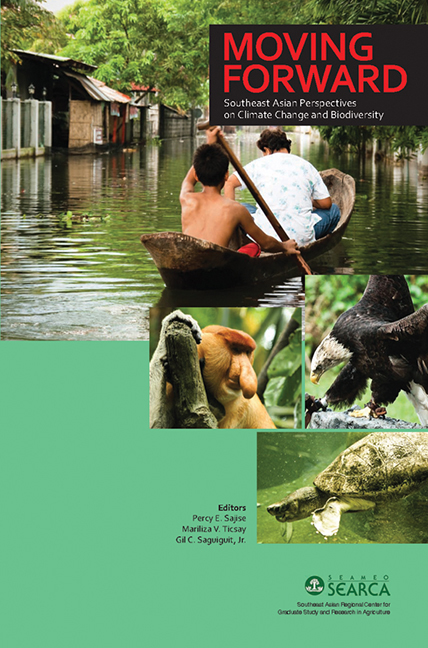Book contents
- Frontmatter
- Contents
- Tables
- Figures
- Foreword
- Preface
- Contributors
- Acronyms
- INTRODUCTION
- REGIONAL PERSPECTIVES AND CROSS-CUTTING ISSUES
- COUNTRY PERSPECTIVES
- 5 Animal Genetic Resource Conservation and Climate Change in Cambodia: Reducing Livestock to Decrease GHG Emission?
- 6 Malaysia's Current Policy and Research Initiatives Toward Climate Change: Impacts to Biodiversity
- 7 Anticipated Impacts of Climate Change on Marine Biodiversity: Using Field Situations that Simulate Climate Change in Singapore
- 8 Climate Change and Biodiversity in the Philippines: Potential Impacts and Adaptation Strategies
- 9 Research Initiatives on Climate Change Impacts and Adaptation in Thailand
- 10 The Role of Biodiversity in Climate Change Mitigation in Vietnam: The Red River Estuary - Ba Lat Case Study
- 11 Implications of the Dutch-Philippines Biodiversity Research on the Impacts, Vulnerability, and Adaptation to Climate Change: The Coastal Ecosystem
- CHALLENGES AND FUTURE ACTIONS
- Index
8 - Climate Change and Biodiversity in the Philippines: Potential Impacts and Adaptation Strategies
from COUNTRY PERSPECTIVES
Published online by Cambridge University Press: 21 October 2015
- Frontmatter
- Contents
- Tables
- Figures
- Foreword
- Preface
- Contributors
- Acronyms
- INTRODUCTION
- REGIONAL PERSPECTIVES AND CROSS-CUTTING ISSUES
- COUNTRY PERSPECTIVES
- 5 Animal Genetic Resource Conservation and Climate Change in Cambodia: Reducing Livestock to Decrease GHG Emission?
- 6 Malaysia's Current Policy and Research Initiatives Toward Climate Change: Impacts to Biodiversity
- 7 Anticipated Impacts of Climate Change on Marine Biodiversity: Using Field Situations that Simulate Climate Change in Singapore
- 8 Climate Change and Biodiversity in the Philippines: Potential Impacts and Adaptation Strategies
- 9 Research Initiatives on Climate Change Impacts and Adaptation in Thailand
- 10 The Role of Biodiversity in Climate Change Mitigation in Vietnam: The Red River Estuary - Ba Lat Case Study
- 11 Implications of the Dutch-Philippines Biodiversity Research on the Impacts, Vulnerability, and Adaptation to Climate Change: The Coastal Ecosystem
- CHALLENGES AND FUTURE ACTIONS
- Index
Summary
THE PHILIPPINES AND CLIMATE CHANGE
Physical and Ecological Features
The Philippines is an archipelagic country composed of 7,107 islands. It generally lies between 116° 40’ and 126° 34' E longitude, and 4° 40' and 21° 10' N latitude. It is bounded on the southwest by Borneo, on the north by Taiwan, on the south by Moluccas and Sulawesi, and on the east by Palau.
The Philippines covers a total of 30 M ha which is almost equally divided between forest lands (15.9 M ha) and alienable and disposable (A&D) lands (14.1 M ha). Of the classified forest lands, 7.2 M ha are forests, 4 M ha are open forests, 2.6 M ha are closed forests, 0.3 M ha are plantations, and 0.2 M ha are mangroves.
In terms of soil types, there are 11 general categories based on the United Nations Food and Agriculture Organization (UN FAO) classification. The categories are: cambisols, gleysols, fluvisols, arenosols, regosols, luvisols, acrisols, andosols, phaeozems, nitisols, and kastanozems. Acrisols and cambisols are the most common types of soil present in many areas of the country as they cover 12 M ha and 8 M ha, respectively.
Topography is varied in the Philippines. The highest point is in Mt. Apo, with an elevation of 2,954 m asl. Lowlands are located in Cagayan Valley and the central plains of Luzon, Cotabato, the Davao-Agusan valleys, and in Negros and Panay.
Based on rainfall distribution, there are four types of climate existing in the Philippines: Type I, Type II, Type III, and Type IV. Climatic Type I is characterized by two pronounced seasons (dry and wet). Climatic Type II has no dry season but has a very pronounced rainfall from November to January. Climatic Type III is somehow in between Climatic Types I and II but is more similar to the Type I climate. It has a relatively short dry season which lasts for one to three months only. In Type IV climate, rainfall is more or less evenly distributed throughout the year.
- Type
- Chapter
- Information
- Moving ForwardSoutheast Asian Perspectives on Climate Change and Biodiversity, pp. 141 - 164Publisher: ISEAS–Yusof Ishak InstitutePrint publication year: 2010



